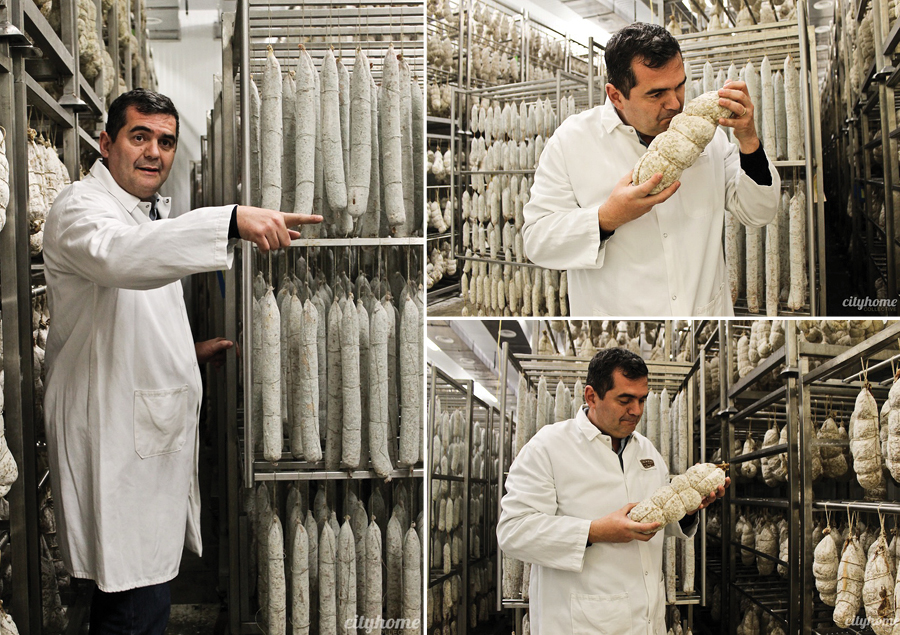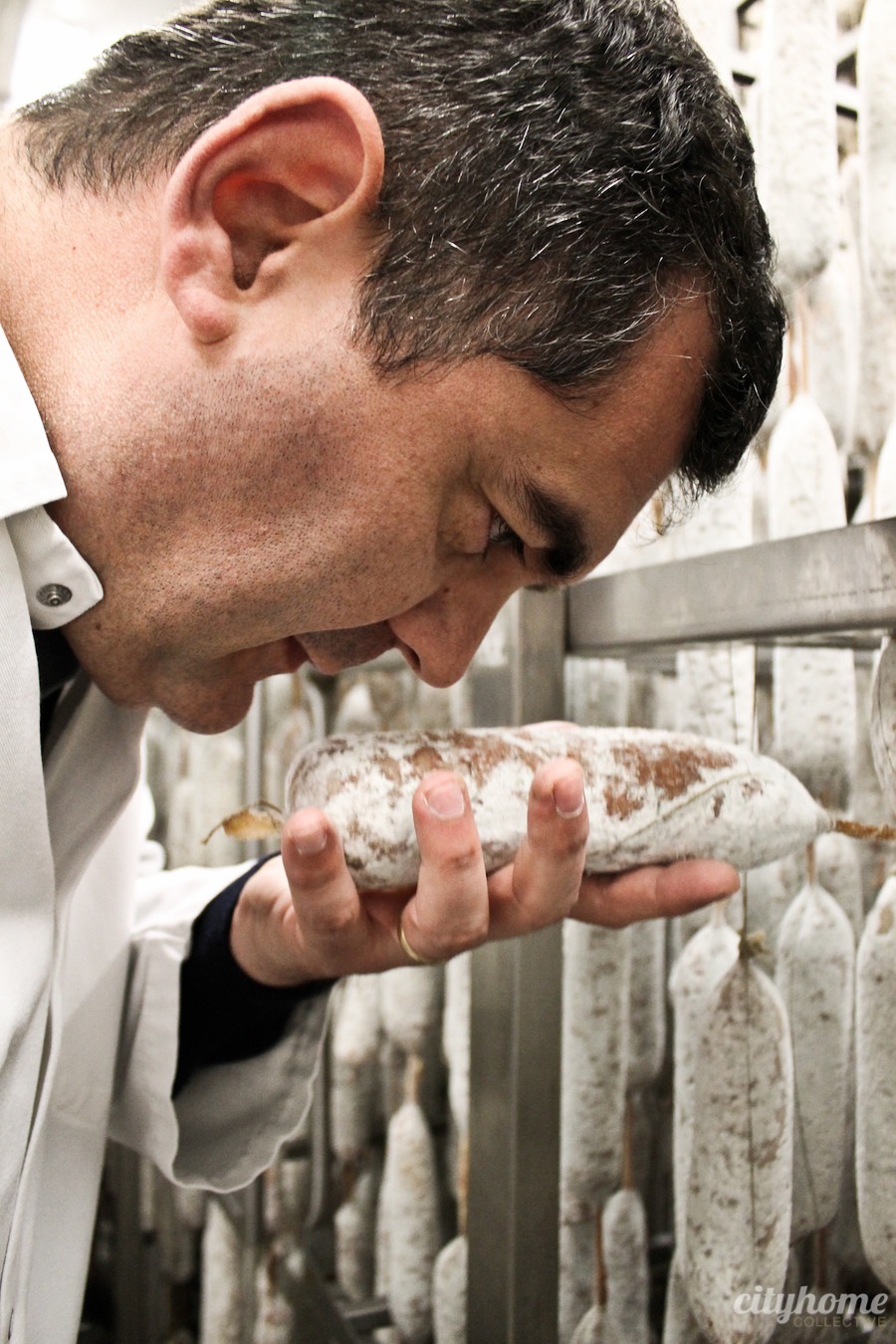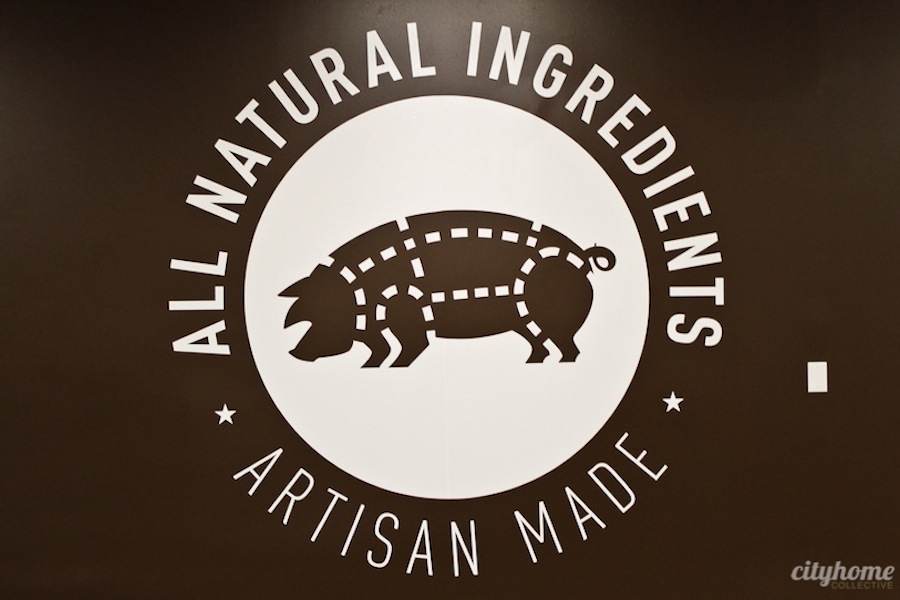What the Oscars are for film, or a Grammy awards excellence in music, the Specialty Food Association “sofi” award goes to the best of the best in the gourmet food world. In 2013, Cristiano Creminelli brought this golden statue [it really does look a bit like an Oscar, but wearing a chef’s toque] for outstanding meat product back to Utah. The winner? His version of “Campania” handcrafted salami stole the show. It’s named after the Campania region of Italy where salami has been made for centuries, and this particular product’s profile echoes that region’s turbulent history of Spanish and Turkish conquerors. Their acquisitive asses may have eventually been kicked out by the Italians, but the undeniably delicious legacy of their spicy chilies, sweet paprika, and cayenne remained. A tradition of curing meat under ashes in terra cotta jars imparted a subtle smoky flavor while at the same time keeping the salami at a cool temperature perfect for the aging process. In the case of this award-winning salami, ash and terra cotta jars were replaced in Creminelli’s state-of-the-art facility with smoky essence and specific climate control in the curing and drying cells. A delicious example of ancient flavors meeting up with modern methods to create a mouthful of “wow” factor.
Campania is just one of the literally hundreds of salami and salumi varieties Cristiano Creminelli has made through his life. To say the craft of salami-making is imprinted on his mitochondrial DNA ain’t far from the mark. Even though Creminelli Fine Meats are produced utilizing computerized climate control and other cutting-edge technology, the methods Cristiano employs to make these kickass products have changed very little since his Italian ancestors started crafting salami in their mountain village in the 1600s. That’s right people, since the freaking seventeenth century. Cristiano grew up working alongside his father, Umberto, and grandfather, Ugo Creminelli at their Salumificio in the foothills of the Italian Alps near Biella in northern Italy [yes, in addition to fabulous shoes and gorgeous motorcraft, Italians have whole shops devoted to salumi. Gawd, we love Italy.] Slow Food—an organization dedicated to recognizing all things local, small-batch, and snail-embellished—honored the Creminelli family’s Salumificio with the coveted Artisanal Excellence award in 2006. Rather than keeping their family traditions marked Top Secret and handing out decoder rings to only a select few, the Creminelli’s have generously shared their passion for salami making. Cristiano taught culinary students at the Piedmont region’s top culinary school, and regularly speaks to groups about the art and craft of making salami.
About a decade ago, Cristiano recognized that real Italian salami was virtually unobtainable in the USA due to import restrictions on dry-cured fermented meat products, and lucky for us he took pity and brought his skills [and damn canny business chops] to us. See, American food paranoia dictates that commercially-available salami usually includes chemical nitrates [bacterial inhibitors], and a “kill step” of cooking at high heat or irradiating the meat to destroy potential pathogens. On the flip side, pretty much every village in Italy has its own family of salami makers using the triumvirate of ancient preservation they’ve used for generations: only pork, salt, and time. It’s delicious alchemy goin’ on here, where each Salumificio plays with the ratio of meat to fat, and adds such mix-ins as herbs, spice, exotics like truffles, liquor, and wine to build flavor. They’ll substitute pork for wild boar, elk, or other game meat. Salami, like great cheese and fine wine, is the result of a sexy tango lead by folks who gather beautiful raw materials and partner them with such ethereal elements as bacteria and yeast naturally floating in the ether all around us. Fermentation and time, plus a whole lotta skill to know what’s a good mold versus a bad funk, is rewarded with some of the most delicious food on the planet. Sure, Creminelli keeps their shit tight: it all goes through the stringent and various USDA and FDA tests confirming proper pH and water content [among a gazillion other things] to get full compliance at the factory, and their salami arrives to your fridge bin with all the appropriate stamps and certifications. But after a lifetime of salami making in the tradition of his family, Cristiano can tell just by smelling, touching, and looking at his salami if it is ready to eat. A salami superhero, if you will. His superpower? He’s a living, breathing, litmus test ninja.
Cristiano decided that in order to bring salami to America, it needed to be made here, using all natural and organic ingredients. He looked at cities all over the US trying to find the perfect combination: he needed a climate closely replicating his home village near the Italian Alps as possible, a pro-business community with an established airport/shipping routes, and a steady and responsibly-raised supply of meat. See, Cristiano very specifically only uses meat from heritage pig varieties like Duroc, raised without antibiotics [which kill the good bacteria necessary for the traditional fermentation process] and with healthy vegetarian feed. Pigs are very social and intelligent animals, and are easily stressed in the crowded environment of modern industrial farming. Cristiano believes that humane animal husbandry produces pigs that are happier, healthier, and end up tasting better as a result. After looking at cities all over the Rocky Mountain and Pacific west, he decided that Salt Lake City met these criterion. SLC = winning. He started out making salami in the basement of Caputo’s Downtown Market in 2006, and quickly the demand for Creminelli Fine Meats outstripped Cristiano’s workspace.
A few years ago, they moved operations to a larger facility near the airport, and while Cristiano still personally visits the curing and drying cells, his manager handles the day-to-day operation of the shop. This gives Cristiano more time and flexibility to teach, to develop new products, and to meet with voracious salami lovers COLLECTIVELY disguised as writers [guilty, as charged].We recently talked with Cristiano Creminelli and Creminelli Fine Meats’ marketing and education manager [and culinary badass] Vanessa Chang about what’s what at the Salumi Mothership.
“Salami” or “Salumi”? Meat terminology 101, please. “Salumi” refers to all of the cured and sometimes cooked stuff in the deli case, like prosciutto, mortadella, and capicola; “salami” describes a specific product: chopped or ground meat that has been fermented and dry cured in natural casing.
So, what goes on in these mysterious curing cells? All of the machinery monitoring temperature, humidity, air flow, and so on comes from Italy. We have these huge parts, compressors, and digital monitors shipped from Italy and assembled here, since this specific type of equipment isn’t made in the US. We move the salami and salumi to different cells [climate-controlled drying rooms] when the meat needs specific conditions as it is aging. But the drying cells still need to be checked in person to monitor how well the products are fermenting, and to check the molds.
Mold, hm. It’s a good thing? Absolutely! Mold is a natural bloom on the salami, it shows that the salami is developing flavor, and protects it. All of our salami is made in natural beef casings and dusted with a bit of rice flour before packaging to equalize moisture, so what you see when you open a package is all safe to eat. Just peel off the casing using your fingers [or start it with the edge of a knife] and you are ready to slice up the salami. Vanessa’s tip: use a heavy serrated knife to slice salami.
So, this is a family tradition that’s been going on since the 1600s. Day-um. Yes, but I’m still learning all the time. My family has made hundreds of different kinds of salumi for generations, but we are still trying out new things. I love what I do, and I am lucky to get to do it every day. I now have a full-time production manager here at the shop, so most of my time is spent doing R & D for new products, looking at new ingredients. We try out food and wine pairings with our salami. It’s delicious work!
Do you get back to Italy much? Yes, we do go to visit, but our family’s home is in Utah now. One of the great things about technology is that when it’s lunch time in Utah, with the time difference my father is having dinner in Italy. We Skype together while we’re eating, and talk about what we’re making, or if I have a question about a recipe I ask him. Of course, then he can ask his father [my grandfather], too. So we are always talking about salami.
Obvi, the Utah climate is working out for salami-making. What other Utah ingredients have you grown to love? There are some wonderful ingredients that I’ve made salami with, like High West whiskey, and oatmeal stout beer made in Utah. And bacon! We have a bacon salami, very unusual and very popular. We still use a lot of ingredients from Italy, too, like Borolo wine and truffles.
You must have folks lining up to learn about salami-making from you. Sure, but most people only have time to spend a couple of hours, or a day. It takes so much longer than that to really figure out how to make good salami. I have been doing it my whole life, and I still discover.
How do we get our greedy paws on your products? They’re available at Caputo’s Markets, of course, and also at Harmon’s Grocery Stores. You can order on-line and have salami shipped [Note: makes a terrific gift. Really, why give dad a boring tie when you can give him goddamn Whiskey Salami. Favorite kid status FTW!], and we have a program called the Creminelli Club where members get a box of carefully-selected products that pair with salami. Last time we had a pizza box with Campania salami, pizza dough ingredients, gorgeous cheese and sauce all ready to go. The June box ships out soon, and it’s one of my favorites so far. Very, very good.











